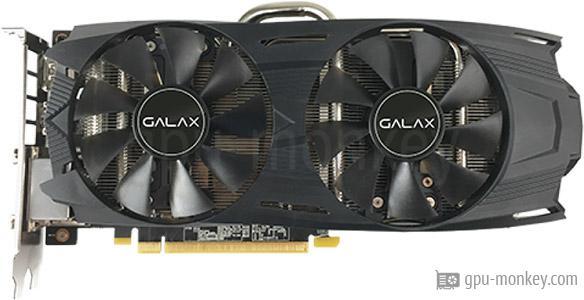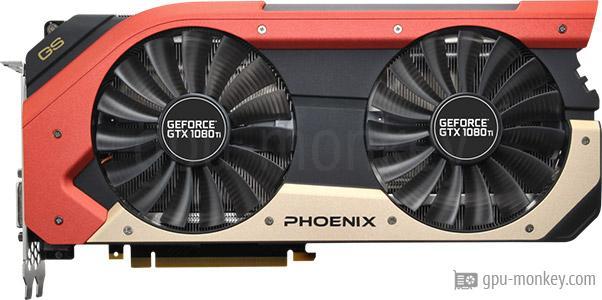GALAX GeForce GTX 1060 EXOC 3GB
vs
Gainward GeForce GTX 1080 Ti Phoenix GS
GPU comparison with benchmarksThe GALAX GeForce GTX 1060 EXOC 3GB has 1152 shader units and these clock a maximum of 1.76 GHz which results in an FP32 computing power of 4.06 TFLOPS.
The Gainward GeForce GTX 1080 Ti Phoenix GS has 3584 shader units and these clock at a maximum of 1.67 GHz and achieve an FP32 computing power of 11.97 TFLOPS. |
||
GPUThe GALAX GeForce GTX 1060 EXOC 3GB is equipped with a graphics chip of the Pascal architecture, which has 9 streaming multiprocessors. The graphics card Gainward GeForce GTX 1080 Ti Phoenix GS is based on the Pascal architecture and is equipped with 28 execution units. |
||
| GALAX GeForce GTX 1060 EXOC 3GB | GPU | Gainward GeForce GTX 1080 Ti Phoenix GS |
| NVIDIA GeForce GTX 1060 3GB | Based on | NVIDIA GeForce GTX 1080 Ti |
| GP106-300-A1 | GPU Chip | GP102-350-K1-A1 |
| Pascal | Architecture | Pascal |
| 9 | Streaming Multiprocessors | 28 |
| 1152 | Shader | 3584 |
| 48 | Render Output Units | 88 |
| 72 | Texture Units | 224 |
| 0 | Raytracing Cores | 0 |
MemoryThe GALAX GeForce GTX 1060 EXOC 3GB is equipped with a 3 GB large GDDR5 graphics memory, which is equipped with 2.002 GHz clocks. The Gainward GeForce GTX 1080 Ti Phoenix GS has a 11 GB large GDDR5X graphics memory and the memory clock is 1.376GHz. |
||
| 3 GB | Memory Size | 11 GB |
| GDDR5 | Memory Type | GDDR5X |
| 2.002 GHz | Memory Clock | 1.376 GHz |
| 8.0 Gbps | Memory Speed | 11.0 Gbps |
| 192 GB/s | Memory bandwidth | 484 GB/s |
| 192 bit | Memory Interface | 352 bit |
Clock SpeedsThe GALAX GeForce GTX 1060 EXOC 3GB has a turbo clock of 1.759 GHz. The turbo frequency of the Gainward GeForce GTX 1080 Ti Phoenix GS is 1.670 GHz. |
||
| 1.544 GHz | Base Clock | 1.556 GHz |
| 1.759 GHz | Boost Clock | 1.670 GHz |
| Avg (Game) Clock | ||
| Yes | Overclocking | Yes |
Thermal DesignThe GALAX GeForce GTX 1060 EXOC 3GB has 1 x 6-Pin connectors through which it is supplied with power. The manufacturer specifies the maximum operating temperature of the graphics card as 94 °C. The Gainward GeForce GTX 1080 Ti Phoenix GS is equipped with a 2 x 8-Pin PCIe power connector that supplies it with power. The maximum operating temperature of the card is 91 °C. |
||
| 120 W | TDP | 250 W |
| -- | TDP (up) | -- |
| 94 °C | Tjunction max | 91 °C |
| 1 x 6-Pin | PCIe-Power | 2 x 8-Pin |
Cooler & FansThe graphics processor and graphics memory of the GALAX GeForce GTX 1060 EXOC 3GB are cooled with a Air cooling. The Gainward GeForce GTX 1080 Ti Phoenix GS is cooled by a Air cooling. |
||
| Axial | Fan-Type | Axial |
| 2 x 90 mm | Fan 1 | 2 x 100 mm |
| -- | Fan 2 | -- |
| Air cooling | Cooler-Type | Air cooling |
| dB | Noise (Idle) | 0 dB |
| -- | Noise (Load) | -- |
ConnectivityThe GALAX GeForce GTX 1060 EXOC 3GB supports the downward compatible copy protection HDCP in version 2.2. The Gainward GeForce GTX 1080 Ti Phoenix GS supports HDCP in version 2.2 and all previous versions. |
||
| 4 | Max. Displays | 4 |
| 2.2 | HDCP-Version | 2.2 |
| 1x HDMI v2.0b | HDMI Ports | 1x HDMI v2.0b |
| 1x DP v1.4 | DP Ports | 3x DP v1.4 |
| 2 | DVI Ports | 1 |
| -- | VGA Ports | -- |
| -- | USB-C Ports | -- |
FeaturesetThe GALAX GeForce GTX 1060 EXOC 3GB supports the DirectX standard from Microsoft in version 12_1. The Gainward GeForce GTX 1080 Ti Phoenix GS supports Microsoft's DirectX version 12_1. |
||
| 7680x4320 | Max. resolution | 7680x4320 |
| 12_1 | DirectX | 12_1 |
| No | Raytracing | No |
| Yes | DLSS / FSR | Yes |
| No LED lighting | LED | No LED lighting |
Supported Video CodecsThis area lists which video codecs can be decoded or encoded by the graphics cards in hardware. As a result, the power consumption can be reduced due to a lower processor load. |
||
| Decode / Encode | h264 | Decode / Encode |
| Decode / Encode | h265 / HEVC | Decode / Encode |
| No | AV1 | No |
| No | VP8 | Decode |
| Decode | VP9 | Decode |
DimensionsThe GALAX GeForce GTX 1060 EXOC 3GB is 42 mm wide and therefore needs the space of 3 PCIe-Slots in the case. The width of the Gainward GeForce GTX 1080 Ti Phoenix GS is 42 mm and thus requires the space of 3 PCIe-Slots in the PC case. |
||
| 268 mm | Length | 285 mm |
| 139 mm | Height | 133 mm |
| 42 mm | Width | -- |
| 2 PCIe-Slots | Width (Slots) | 3 PCIe-Slots |
| -- | Weight | -- |
| PCIe 3.0 x 16 | GPU Interface | PCIe 3.0 x 16 |
Additional dataManufactured using the 16 nanometer process, GALAX GeForce GTX 1060 EXOC 3GB was released in Q3/2016. The Gainward GeForce GTX 1080 Ti Phoenix GS published in Q1/2017 is manufactured with a structure width of 16 nanometers. |
||
| 60NNH7DVM6O3 | Part-no | 426018336-3934 |
| Q3/2016 | Release date | Q1/2017 |
| 199 $ (Reference) | Launch Price | 699 $ (Reference) |
| 16 nm | Structure size | 16 nm |
| data sheet | Documents | data sheet |
Rate these graphics cards now
Benchmark results
3DMark Benchmark (DirectX, Raytracing)
3DMark is a benchmark program that determines the performance of certain components of a computer and then reports the performance as a numerical value.
Time Spy Extreme Graphics score
|
|
GALAX GeForce GTX 1060 EXOC 3GB
3 GB GDDR5 |
||
|
|
Gainward GeForce GTX 1080 Ti Phoenix GS
11 GB GDDR5X |
||
Battlefield 5
Battlefield 5 is a visually stunning game that is ideal as a graphics card benchmark. We test the game with maximum details on Windows 10.
3840x2160 (2160p)
|
|
GALAX GeForce GTX 1060 EXOC 3GB
3 GB GDDR5 |
||
|
|
Gainward GeForce GTX 1080 Ti Phoenix GS
11 GB GDDR5X |
||
2560x1440 (1440p)
|
|
GALAX GeForce GTX 1060 EXOC 3GB
3 GB GDDR5 |
||
|
|
Gainward GeForce GTX 1080 Ti Phoenix GS
11 GB GDDR5X |
||
1920x1080 (1080p)
|
|
GALAX GeForce GTX 1060 EXOC 3GB
3 GB GDDR5 |
||
|
|
Gainward GeForce GTX 1080 Ti Phoenix GS
11 GB GDDR5X |
||
Geekbench 6 (OpenCL, Vulkan, Metal)
Geekbench 6 is a cross-platform benchmark for main processors, which also carries out 3 different graphics benchmarks and outputs them in the form of a numerical value.
Geekbench 6 - OpenCL
|
|
GALAX GeForce GTX 1060 EXOC 3GB
3 GB GDDR5 |
||
|
|
Gainward GeForce GTX 1080 Ti Phoenix GS
11 GB GDDR5X |
||
Geekbench 6 - Vulkan
|
|
GALAX GeForce GTX 1060 EXOC 3GB
3 GB GDDR5 |
||
|
|
Gainward GeForce GTX 1080 Ti Phoenix GS
11 GB GDDR5X |
||
FP32 Performance (Single-precision TFLOPS)
The theoretical computing power of the graphics card with single precision (32 bit) in TFLOPS indicates how many trillion FP32 floating point operations the graphics card (GPU) can perform per second.
FP32 (TFLOPS)
|
|
GALAX GeForce GTX 1060 EXOC 3GB
3 GB GDDR5 |
||
|
|
Gainward GeForce GTX 1080 Ti Phoenix GS
11 GB GDDR5X |
||








